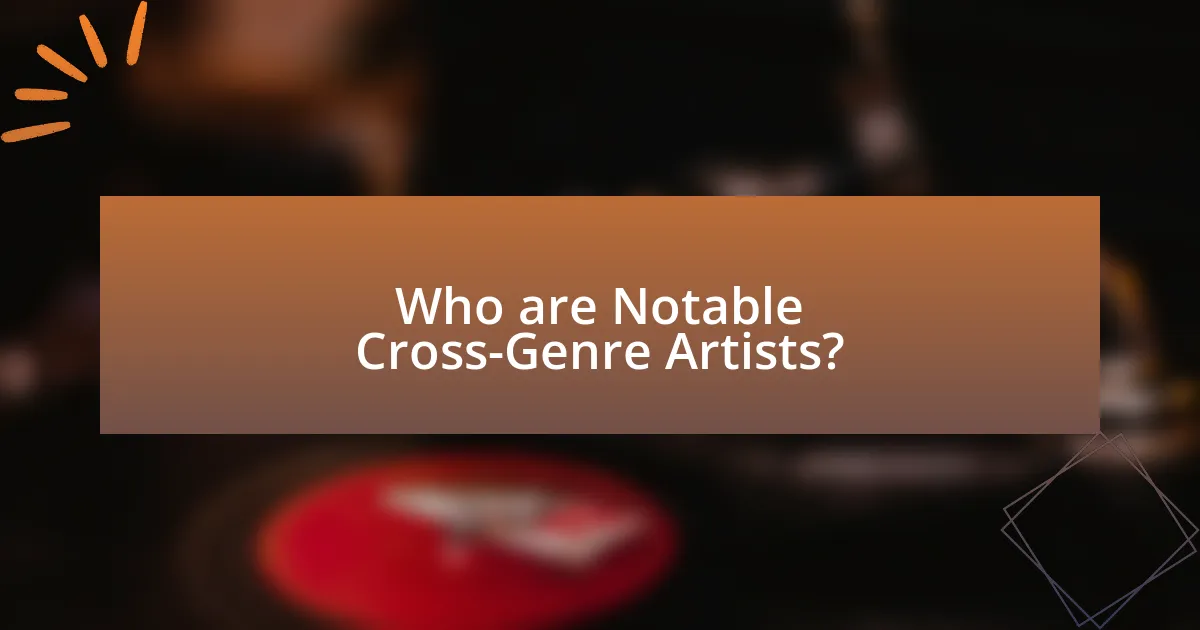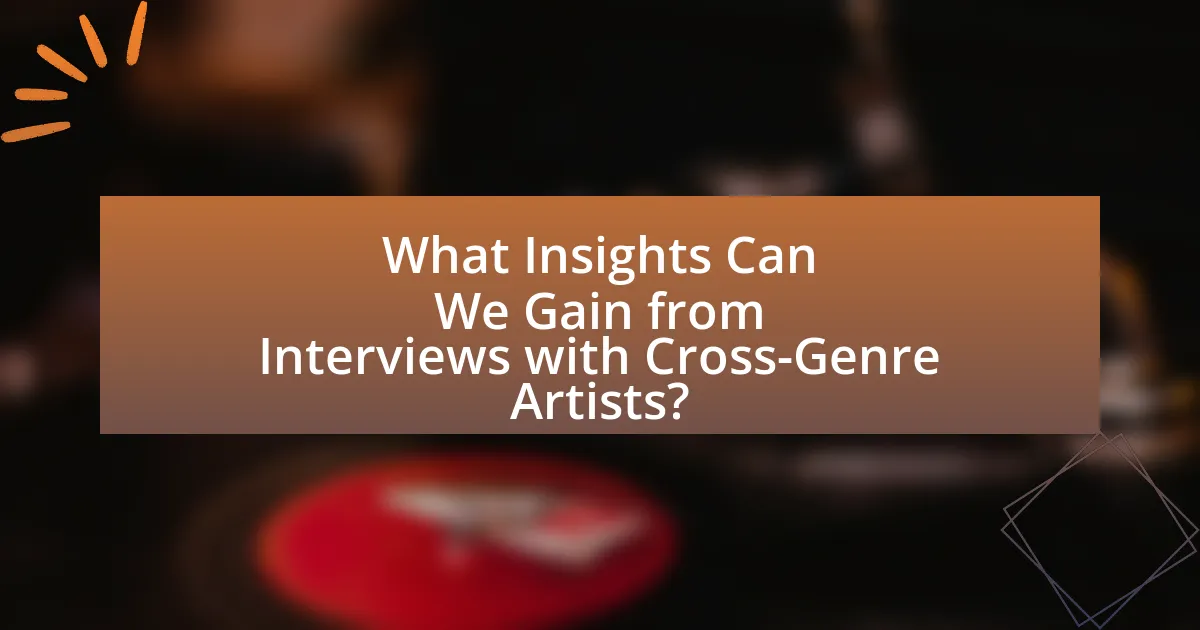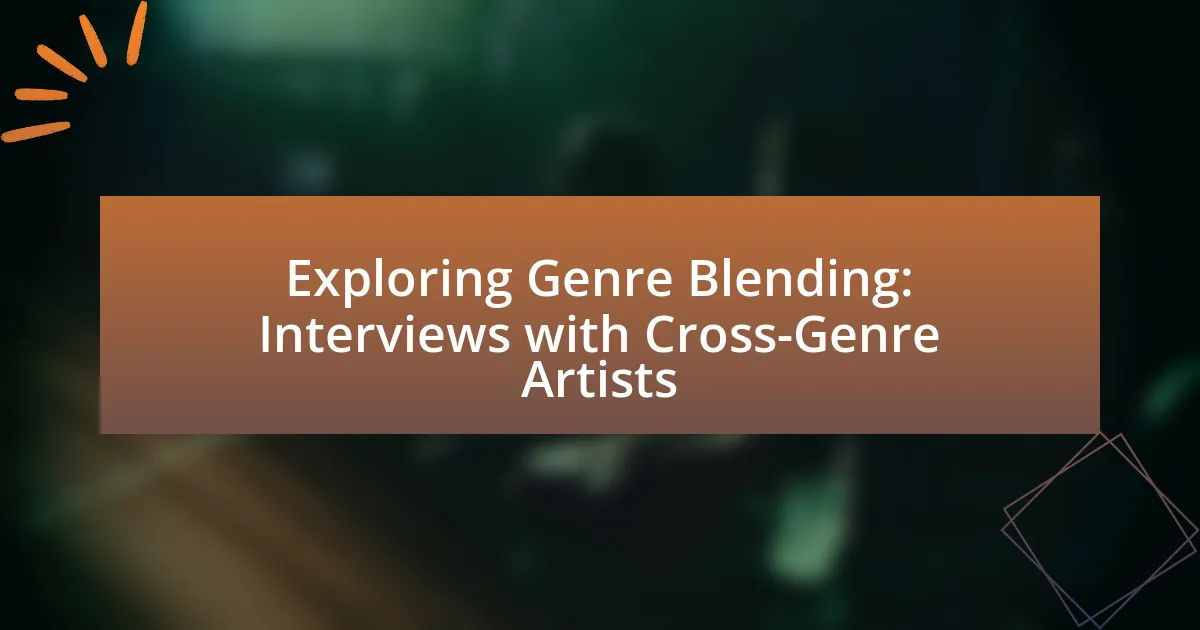Genre blending in music involves the fusion of elements from various musical genres to create innovative, hybrid sounds that appeal to a wider audience. This article explores the concept of genre blending, highlighting its differences from traditional genre classifications, key characteristics, and the historical roots that have shaped its evolution. It examines the growing popularity of cross-genre artists, such as Billie Eilish and Lil Nas X, and discusses the impact of cultural exchanges on music. Additionally, insights from interviews with these artists reveal their creative processes, challenges, and the techniques they use to effectively blend genres, providing valuable advice for aspiring musicians.

What is Genre Blending in Music?
Genre blending in music refers to the combination of elements from different musical genres to create a new, hybrid sound. This practice allows artists to experiment with diverse influences, resulting in innovative styles that can appeal to a broader audience. For example, the fusion of hip-hop and country music has gained popularity, exemplified by artists like Lil Nas X with his hit “Old Town Road,” which topped charts across multiple genres. This blending not only reflects the evolving nature of music but also showcases the creativity and versatility of contemporary musicians.
How does genre blending differ from traditional genre classifications?
Genre blending combines elements from multiple genres, creating a hybrid form that defies strict categorization, while traditional genre classifications strictly define works based on specific characteristics and conventions. Traditional classifications often limit artistic expression by enforcing rigid boundaries, whereas genre blending encourages innovation and experimentation, allowing artists to reach diverse audiences and explore new creative avenues. This approach reflects the evolving nature of art and culture, as seen in the rise of cross-genre music, literature, and film, where successful examples like the fusion of hip-hop and jazz or the combination of science fiction and romance illustrate the appeal and impact of genre blending.
What are the key characteristics of genre-blending music?
Genre-blending music is characterized by the fusion of elements from multiple musical genres, creating a unique sound that transcends traditional boundaries. This blending often involves the incorporation of diverse instrumentation, varied rhythmic patterns, and distinct vocal styles, allowing for innovative compositions that appeal to a broader audience. For instance, artists like Billie Eilish combine pop with electronic and indie influences, showcasing how genre-blending can lead to new musical expressions. Additionally, genre-blending music often reflects cultural diversity, as it draws from different musical traditions, enhancing its richness and complexity.
Why is genre blending becoming more popular among artists?
Genre blending is becoming more popular among artists due to the increasing demand for innovative and diverse musical experiences. This trend allows artists to reach broader audiences by combining elements from different genres, which can lead to unique sounds that resonate with listeners across various demographics. For instance, the rise of streaming platforms has facilitated genre exploration, enabling artists to experiment without the constraints of traditional genre labels. Additionally, collaborations between artists from different genres have become more common, further promoting genre blending as a creative strategy. This shift reflects a cultural movement towards inclusivity and experimentation in music, as evidenced by the success of cross-genre hits that dominate charts today.
What are the historical roots of genre blending?
The historical roots of genre blending can be traced back to the early 20th century, particularly with the emergence of jazz, which combined elements of African American musical traditions, blues, and European classical music. This fusion laid the groundwork for subsequent genre blending across various music styles, as artists began to experiment with mixing different influences. For instance, the 1960s saw rock music incorporate elements of folk, blues, and psychedelia, further exemplifying the trend of genre blending. Additionally, the rise of hip-hop in the late 20th century showcased a blend of spoken word, funk, and electronic music, solidifying genre blending as a significant aspect of musical evolution. These historical developments illustrate how genre blending has been a continuous process influenced by cultural exchanges and artistic innovation.
How have past musical movements influenced contemporary genre blending?
Past musical movements have significantly influenced contemporary genre blending by providing foundational styles and innovative techniques that artists draw upon today. For instance, the fusion of jazz and rock in the 1960s led to the development of jazz-rock, which has inspired modern artists to combine elements from various genres, such as hip-hop and electronic music. Additionally, the punk movement’s DIY ethos encouraged genre experimentation, prompting artists to blend genres like punk and pop, resulting in new subgenres like pop-punk. Historical examples include the emergence of reggae’s influence on hip-hop in the 1980s, which showcased how rhythmic and lyrical elements can transcend genres, further enriching contemporary music.
What role do cultural exchanges play in genre blending?
Cultural exchanges play a crucial role in genre blending by facilitating the fusion of diverse musical styles and traditions. These exchanges allow artists to draw inspiration from different cultural backgrounds, leading to innovative combinations that transcend traditional genre boundaries. For instance, the incorporation of African rhythms into American jazz has resulted in unique subgenres like Afrobeat, showcasing how cultural interactions can reshape musical landscapes. Furthermore, studies indicate that cross-cultural collaborations often lead to the creation of new genres, as seen in the rise of Reggaeton, which blends Latin rhythms with hip-hop and dancehall influences. This evidence underscores the significant impact of cultural exchanges on the evolution of music genres.

Who are Notable Cross-Genre Artists?
Notable cross-genre artists include David Bowie, who seamlessly blended rock, pop, and electronic music, and Billie Eilish, known for her fusion of pop, electronic, and alternative sounds. These artists exemplify genre blending by creating innovative music that defies traditional categorization, attracting diverse audiences and influencing various musical styles. David Bowie’s work, particularly in albums like “The Rise and Fall of Ziggy Stardust and the Spiders from Mars,” showcases his ability to merge different genres, while Billie Eilish’s debut album “When We All Fall Asleep, Where Do We Go?” highlights her unique sound that incorporates elements from multiple genres.
What are some examples of successful cross-genre artists?
Successful cross-genre artists include Taylor Swift, who transitioned from country to pop, and Lil Nas X, who blends country and hip-hop. Taylor Swift’s album “1989” marked her shift to pop, earning her a Grammy for Album of the Year. Lil Nas X’s “Old Town Road” topped the Billboard Hot 100 for a record-breaking 19 weeks, showcasing the fusion of country and rap. Other notable examples are Billie Eilish, who incorporates elements of pop, electronic, and indie, and Post Malone, who merges hip-hop, rock, and pop influences in his music.
How have these artists defined their unique sound?
These artists have defined their unique sound by blending elements from various musical genres, creating a distinctive auditory experience. For instance, they often incorporate diverse instrumentation and innovative production techniques, which allows them to transcend traditional genre boundaries. This approach is evident in the works of artists like Billie Eilish, who combines pop with electronic and indie influences, resulting in a sound that is both contemporary and unique. Additionally, collaborations with artists from different genres further enrich their musical palette, showcasing their versatility and commitment to experimentation.
What challenges have they faced in their genre-blending journeys?
Artists engaged in genre-blending often face challenges such as audience reception, industry categorization, and creative identity. Audience reception can be unpredictable, as listeners may have preconceived notions about specific genres, making it difficult for artists to gain traction. Industry categorization poses another challenge, as record labels and distributors typically prefer to market music within established genres, which can limit opportunities for cross-genre artists. Additionally, maintaining a coherent creative identity while experimenting with diverse styles can lead to internal conflicts, as artists navigate the expectations of both their existing fan base and potential new listeners. These challenges highlight the complexities of genre-blending in the music industry.
What impact do cross-genre artists have on the music industry?
Cross-genre artists significantly impact the music industry by expanding the boundaries of musical creativity and audience reach. These artists often blend elements from various genres, leading to innovative sounds that attract diverse listener demographics. For instance, the rise of artists like Lil Nas X, who fused country and hip-hop, resulted in the genre-defying hit “Old Town Road,” which topped the Billboard Hot 100 for a record-breaking 19 weeks in 2019. This blending not only challenges traditional genre classifications but also encourages collaboration among artists from different backgrounds, fostering a more inclusive music scene. Additionally, cross-genre music often performs well on streaming platforms, as algorithms favor diverse playlists, further enhancing visibility and accessibility for these artists.
How do they influence trends in music consumption?
Cross-genre artists influence trends in music consumption by introducing innovative sounds that attract diverse audiences. Their unique blends of musical styles challenge traditional genre boundaries, leading to increased streaming and sales across platforms. For instance, the rise of artists like Lil Nas X, who combines country and hip-hop, has resulted in significant shifts in listener preferences, as evidenced by his song “Old Town Road” topping the Billboard charts for a record-breaking 19 weeks. This genre-blending not only expands the listener base but also encourages music platforms to promote a wider variety of genres, ultimately shaping consumption patterns in the industry.
What changes have they prompted in music production and marketing?
Genre blending has prompted significant changes in music production and marketing by encouraging the use of diverse sounds and collaborative techniques. This shift has led to the integration of various musical styles, allowing producers to experiment with unconventional combinations, which enhances creativity and broadens audience appeal. For instance, the rise of artists like Lil Nas X, who blends country and hip-hop, demonstrates how genre fusion can create viral hits and attract diverse listener demographics. Additionally, marketing strategies have evolved to leverage social media platforms, where cross-genre collaborations can quickly gain traction through viral challenges and trends, exemplified by TikTok’s role in promoting songs across genres. This transformation in both production and marketing reflects a more inclusive and innovative approach to music, aligning with contemporary consumer preferences for varied musical experiences.

What Insights Can We Gain from Interviews with Cross-Genre Artists?
Interviews with cross-genre artists provide insights into the creative processes and influences that shape their work. These artists often discuss how blending different musical styles allows them to explore new themes and emotions, leading to innovative soundscapes. For example, artists like Billie Eilish and Lil Nas X have successfully merged pop with elements of hip-hop and country, respectively, demonstrating how genre fusion can attract diverse audiences and challenge traditional music boundaries. Additionally, such interviews reveal the artists’ perspectives on cultural identity and the evolving music industry, highlighting the importance of adaptability and experimentation in their careers.
What common themes emerge from interviews with these artists?
Common themes that emerge from interviews with cross-genre artists include the importance of creative freedom, the influence of diverse musical backgrounds, and the desire to challenge traditional genre boundaries. These artists often express that their ability to blend genres allows for greater artistic expression and innovation. For instance, many cite personal experiences and cultural influences as key factors that shape their unique sound, demonstrating how their varied backgrounds contribute to their music. Additionally, artists frequently discuss the collaborative nature of their work, emphasizing how partnerships across genres lead to fresh ideas and new perspectives in their creative processes.
How do their personal experiences shape their music?
Personal experiences significantly shape artists’ music by influencing their lyrical content, emotional expression, and stylistic choices. For instance, artists often draw from their life events, cultural backgrounds, and personal struggles, which manifest in their songs’ themes and narratives. Research indicates that autobiographical elements in music can enhance listener connection and authenticity, as seen in the works of artists like Taylor Swift and Kendrick Lamar, who incorporate personal stories to resonate with audiences. This connection between personal experience and musical expression is evident in the way artists blend genres, reflecting their diverse influences and life journeys.
What advice do they offer to aspiring cross-genre musicians?
Aspiring cross-genre musicians are advised to embrace their unique influences and experiment with diverse sounds. This approach allows them to create innovative music that resonates with a broader audience. Successful cross-genre artists emphasize the importance of authenticity and staying true to one’s artistic vision while being open to collaboration across different musical styles. For instance, artists like Billie Eilish and Lil Nas X have successfully blended genres, showcasing that versatility can lead to commercial success and critical acclaim.
How do cross-genre artists perceive their creative process?
Cross-genre artists perceive their creative process as a fluid and dynamic interplay of diverse musical influences. They often describe their approach as one that embraces experimentation, allowing them to draw inspiration from various genres to create unique soundscapes. For instance, artists like Billie Eilish and Lil Nas X have successfully blended pop, hip-hop, and electronic elements, showcasing how cross-genre experimentation can lead to innovative music that resonates with a wide audience. This perception is supported by the increasing popularity of genre-blending tracks on platforms like Spotify, where playlists featuring mixed genres have seen significant growth, indicating a shift in listener preferences towards more eclectic sounds.
What techniques do they use to blend different genres effectively?
Artists blend different genres effectively by employing techniques such as hybridization, thematic integration, and cross-genre instrumentation. Hybridization involves combining elements from distinct genres to create a new sound, as seen in the fusion of rock and hip-hop in the works of artists like Linkin Park. Thematic integration allows artists to explore universal themes that resonate across genres, enabling a seamless transition between styles, exemplified by the storytelling in country and pop collaborations. Cross-genre instrumentation, where artists incorporate instruments typical of one genre into another, enhances the richness of the music, as demonstrated by the use of traditional folk instruments in contemporary electronic music. These techniques facilitate a cohesive blend that appeals to diverse audiences while maintaining the integrity of each genre.
How do they overcome creative blocks in their genre-blending efforts?
Artists overcome creative blocks in their genre-blending efforts by employing various strategies such as collaboration, experimentation, and seeking inspiration from diverse sources. Collaboration allows artists to gain new perspectives and ideas, which can break through mental barriers. Experimentation with different sounds, techniques, or styles encourages innovation and can lead to unexpected breakthroughs. Additionally, drawing inspiration from a wide range of influences, including other art forms, cultures, and personal experiences, helps to refresh their creative process and stimulate new ideas. These methods are supported by the understanding that creativity often thrives in environments that encourage exploration and openness to new possibilities.
What are the best practices for aspiring cross-genre artists?
Aspiring cross-genre artists should focus on developing a unique sound by blending elements from multiple genres while maintaining authenticity. This involves studying various musical styles, experimenting with different instruments, and collaborating with artists from diverse backgrounds to gain new perspectives. Research indicates that artists who successfully blend genres often have a deep understanding of the conventions and techniques of each genre they incorporate, allowing them to innovate effectively. For example, artists like Billie Eilish and Lil Nas X have gained recognition for their genre-blending approaches, showcasing the commercial viability of this practice.
